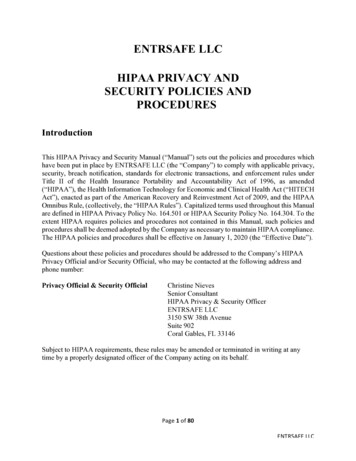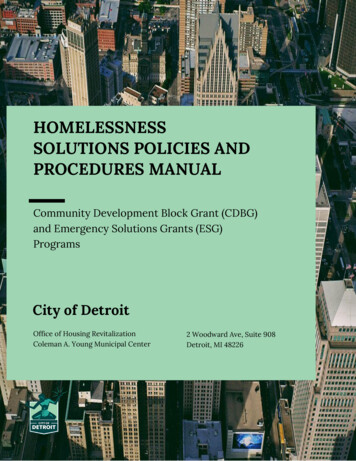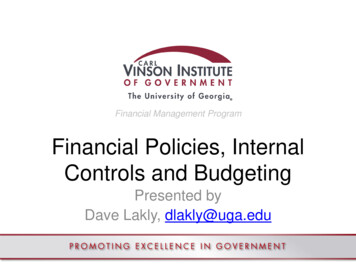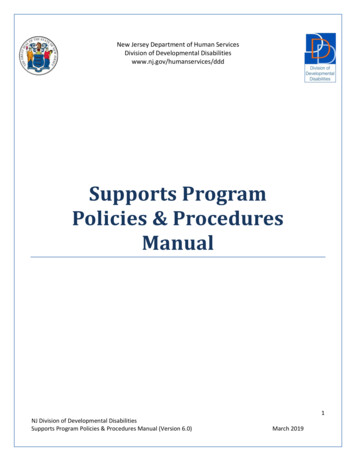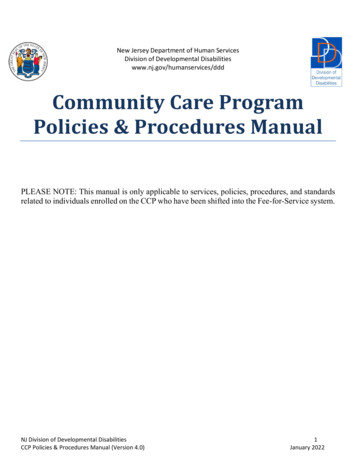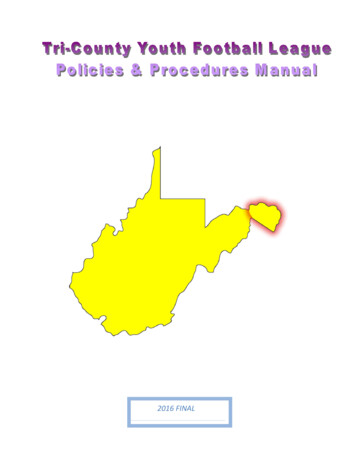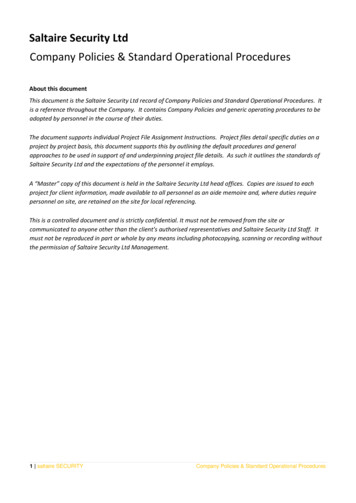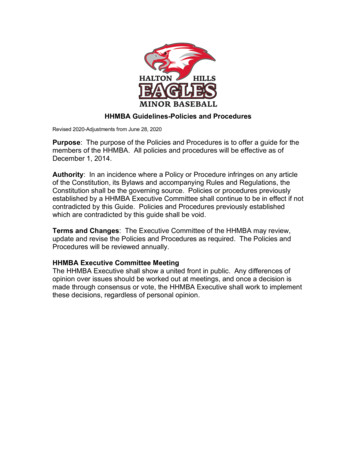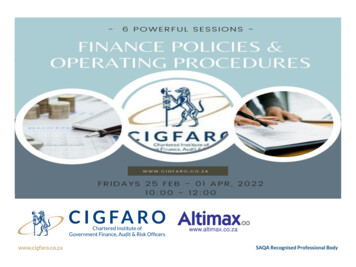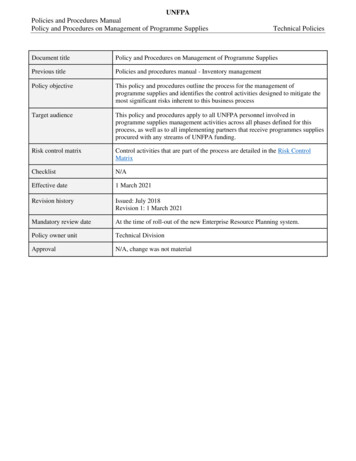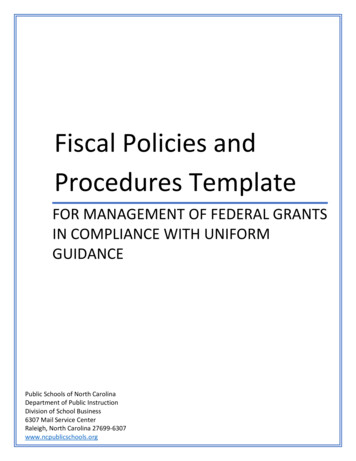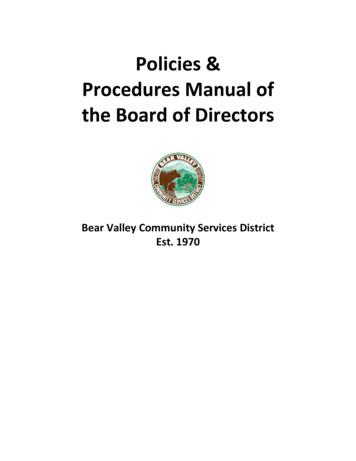
Transcription
Policies &Procedures Manual ofthe Board of DirectorsBear Valley Community Services DistrictEst. 1970
ContentsBoard of Directors Policies and ProceduresPart 1Meeting Procedures & Rules of OrderPart 2Meeting Conduct PolicyPart 3Board of Directors Ethics PolicyPart 4Training & Travel Reimbursement PolicyPart 5Brown Act Compliance PolicyPart 6Public Records Request PolicyPart 7Social Media PolicyPart 8Prevention & Correction of Harassment, Discrimination & Retaliation PolicyPart 9Conflict of Interest CodePart 10Special District Board Member Handbook
PART 1BVCSDMEETING PROCEDURES ANDRULES OF ORDERAdopted: February 8, 2018
INTRODUCTIONESTABLISHING A QUORUMTHE ROLE OF THE CHAIRTHE BASIC FORMAT FOR AGENDA ITEM DISCUSSIONMOTIONS IN GENERALTHE THREE BASIC MOTIONSMULTIPLE MOTIONS BEFORE THE BOARDDEBATABLE AND NON-DEBATABLE MOTIONSMAJORITY AND SUPER MAJORITY VOTESCOUNTING VOTESTHE MOTION TO RECONSIDERCOURTESY AND DECORUMSPECIAL NOTES ABOUT PUBLIC PARTICIPATION
IntroductionThese meeting procedures and rules of order were adapted from Judge DavidRosenberg’s Rosenberg’s Rules of Order (2011 Revised Edition). 1Establishing a QuorumThe starting point for a meeting of the Board is the establishment of a quorum. A quorumis defined as the minimum number of members of the body who must be present at a meeting forbusiness to be legally transacted. The quorum for the Board is three members. When the Boardhas three members present, it can legally transact business. If the Board has less than a quorumof members present, it cannot legally transact business. And even if the Board has a quorum tobegin the meeting, the Board can lose the quorum during the meeting when a member departs(or even when a member leaves the dais). When that occurs, the Board loses its ability to transactbusiness until a quorum is reestablished.The Role of the ChairThe chair of the Board is charged with applying the rules of conduct of the meeting. Thechair should be well versed in those rules. The chair, in consultation with the General Counsel,makes the final ruling on the rules. All decisions by the chair are final unless overruled by theBoard itself.Since the chair runs the conduct of the meeting, it is usual courtesy for the chair to play aless active role in the debate and discussion than other members of the Board. This does notmean that the chair should not participate in the debate or discussion. The chair has the full rightto participate in the debate, discussion and decision-making of the Board. What the chair shoulddo, however, is strive to be the last to speak at the discussion and debate stage. The chair shouldnot make or second a motion unless the chair is convinced that no other member of the Boardwill do so at that point in time.The Basic Format for Agenda Item DiscussionMeetings of the Board must have a published agenda under the Ralph M. Brown Act. Theagenda constitutes the Board’s agreed-upon roadmap for the meeting. Each agenda item shouldbe handled by the chair in the following basic format:1.The chair should clearly announce the agenda item number and subject. The chairshould then announce the format (which follows) that will be followed in considering the agendaitem.2.The chair should invite the appropriate person or persons to report on the item,including any recommendation that they might have. The appropriate person or persons may bethe chair, a member of the Board, a staff person, or a committee chair charged with providinginput on the agenda item.1The original text of Rosenberg’s Rules of Order is available at ure-simplified.
3.The chair should ask members of the Board if they have any technical questionsfor clarification. At this point, members of the Board may ask clarifying questions to the person orpersons who reported on the item, and that person or persons should be given time to respond.4.The chair should invite public comments, or if required, open the public hearing onthe item. If numerous members of the public indicate a desire to speak to the subject, the chairmay limit the time of public speakers. At the conclusion of the public comments, the chair shouldannounce that public input has concluded (or the public hearing, as the case may be, is closed).5.The chair should invite general discussion or deliberation on the item by the Board.6.After discussion among all members, the chair should invite a motion. The chairshould announce the name of the member of the Board who makes the motion.7.The chair should determine if any member of the Board wishes to second themotion. The chair should announce the name of the member of the Board who seconds themotion.8.If the motion is made and seconded, the chair should make sure everyoneunderstands the motion.This is done in one of three ways:1.2.3.The chair can ask the maker of the motion to repeat it;The chair can repeat the motion; orThe chair can ask the secretary or the clerk of the Board to repeat themotion.9.The chair should invite specific discussion of the motion by the Board. If there isno desired discussion, or after the discussion has ended, the chair should announce that theBoard will vote on the motion. If there has been no discussion or very brief discussion, then thevote on the motion should proceed immediately and there is no need to repeat the motion. If therehas been substantial discussion, then it is normally best to make sure everyone understands themotion by repeating it.10.The chair calls for a vote. Voting on most substantive matters must be by a “rollcall vote” where each member’s name is called and they speak or electronically input their vote.If members of the Board do not vote, then they “abstain.” Unless the rules of the Board provideotherwise (or unless a super majority is required as provided in these rules), then a simple majority(as defined in law or the rules of the Board as provided in these rules) determines whether themotion passes or is defeated.11.The chair (or secretary) should announce the result of the vote and what action (ifany) the Board has taken. In announcing the result, the names of the members of the Board, ifany, who voted in the minority on the motion should be indicated. This announcement might takethe following form: “The motion passes by a vote of 3-2, with Smith and Jones dissenting.”
Motions in GeneralMotions are the vehicles for decision making by a Board. Motions are made in a simpletwo-step process. First, the chair should recognize the member of the Board. Second, the memberof the Board makes a motion by preceding the member’s desired approach with the words “I move.”A typical motion might be: “I move that we give a 10-day notice in the future for all ourmeetings.”The chair may initiate the motion in one of three ways:1.Inviting the members of the Board to make a motion: “A motion at this time wouldbe in order.”2.Suggesting a motion to the members of the Board: “A motion would be in orderthat we give a 10-day notice in the future for all our meetings.”3.Making the motion. As noted, the chair has every right as a member of the Boardto make a motion, but should normally do so only if the chair wishes to make amotion on an item but is convinced that no other member of the Board is willing tostep forward to do so at a particular time.The Three Basic MotionsThere are three common types of motions:Basic Motion. The basic motion is the one that puts forward a decision for the Board’sconsideration. A basic motion might be: “I move that we create a five-member committee to planand put on our annual fundraiser.”Motion to Amend. If a member wants to change a basic motion that is before the Board,they would move to amend it. A motion to amend might be: “I move that we amend the motion tohave a 10-member committee.” A motion to amend takes the basic motion that is before the Boardand seeks to change it in some way.Substitute Motion. If a member wants to completely do away with the basic motion thatis before the Board, and put a new motion before the Board, they would move a substitute motion.A substitute motion might be: “I move a substitute motion that we cancel the annual fundraiserthis year.”“Motions to amend” and “substitute motions” are often confused, but they are quitedifferent, and their effect (if passed) is quite different. A motion to amend seeks to retain the basicmotion on the floor, but modify it in some way. A substitute motion seeks to throw out the basicmotion on the floor, and substitute a new and different motion for it. The decision as to whether amotion is really a “motion to amend” or a “substitute motion” is left to the chair. So if a membermakes what that member calls a “motion to amend,” but the chair determines that it is really a“substitute motion,” then the chair’s designation governs.
Friendly Amendment. A “friendly amendment” is a practical tool that saves time andavoids bogging a meeting down with numerous formal motions. It works in the following way: Inthe discussion on a pending motion, it may appear that a change to the motion is desirable ormay win support for the motion from some members. When that happens, a member who has thefloor may simply say, “I want to suggest a friendly amendment to the motion.” The membersuggests the friendly amendment, and if the maker and the person who seconded the motionpending accepts the friendly amendment, that now becomes the pending motion. If either themaker or the person who seconded rejects the proposed friendly amendment, then the proposercan formally move to amend.Multiple Motions Before the BoardThere can be up to three motions pending at the same time. The chair can reject a fourthmotion until the chair has dealt with the three that are pending and has resolved them. This rulehas practical value because more than three motions on the floor at any given time is confusingand unwieldy for almost everyone, including the chair.When there are two or three motions pending (after motions and seconds) at the sametime, the vote should proceed first on the last motion that is made.Debatable and Non-Debatable MotionsThe basic rule of motions is that they are subject to discussion and debate. The debatecan continue as long as members of the Board wish to discuss an item, subject to the decision ofthe chair that it is time to move on and take action.There are exceptions to the general rule of free and open debate on motions. Theexceptions all apply when there is a desire of the Board to move on. The following motions arenot debatable (that is, when the following motions are made and seconded, the chair mustimmediately call for a vote of the Board without debate on the motion):Motion to Adjourn. This motion, if passed, requires the Board to immediately adjourn toits next regularly scheduled meeting. It requires a simple majority vote.Motion to Recess. This motion, if passed, requires the Board to immediately take arecess. Normally, the chair determines the length of the recess which may be a few minutes oran hour. It requires a simple majority vote.Motion to Fix the Time to Adjourn. This motion, if passed, requires the Board to adjournthe meeting at the specific time set in the motion. For example, the motion might be: “I move weadjourn this meeting at midnight.” It requires a simple majority vote.Motion to Table. This motion, if passed, requires discussion of the agenda item to behalted and the agenda item to be placed on “hold.” The motion can contain a specific time in whichthe item can come back to the Board. “I move we table this item until our regular meeting inOctober.” Or the motion can contain no specific time for the return of the item, in which case amotion to take the item off the table and bring it back to the Board will have to be taken at a futuremeeting. A motion to table an item (or to bring it back to the Board) requires a simple majorityvote.
Motion to Limit Debate. The most common form of this motion is to say, “I move thequestion” or “I call the question.” As a practical matter, when a member calls out one of thesephrases, the chair can expedite matters by treating it as a “request” rather than as a formal motion.The chair can simply inquire of the Board, “any further discussion?” If no one wishes to havefurther discussion, then the chair can go right to the pending motion. However, if even one personwishes to discuss the pending motion further, then at that point, the chair should treat the call forthe “question” as a formal motion, and proceed to it.When a member of the Board makes such a motion (“I move the question”), the memberis really saying: “I’ve had enough debate. Let’s get on with the vote.” When such a motion is made,the chair should ask for a second, stop debate, and vote on the motion to limit debate. The motionto limit debate requires a two-thirds vote of the Board.NOTE: A motion to limit debate could include a time limit. For example: “I move we limitdebate on this agenda item to 15 minutes.” Even in this format, the motion to limit debaterequires a two-thirds vote of the Board.Majority and Super Majority VotesGenerally, a simple majority vote determines a question. A tie vote means the motion fails.All motions require a simple majority, but there are a few exceptions. The exceptions come upwhen the Board is taking an action which effectively cuts off the ability of a minority of the Boardto take an action or discuss an item. These extraordinary motions require a two-thirds majority (asuper majority) to pass:Motion to Limit Debate. Whether a member says, “I move the question,” or “I move tolimit debate,” it all amounts to an attempt to cut off the ability of the minority to discuss an item,and it requires a two-thirds vote to pass.Motion to Close Nominations. When choosing officers of the Board (such as the chair),nominations are in order either from a nominating committee or from the floor of the Board. Amotion to close nominations effectively cuts off the right of the minority to nominate officers and itrequires a two-thirds vote to pass.Motion to Object to the Consideration of a Question. Normally, such a motion isunnecessary since the objectionable item can be tabled or defeated straight up. However, whenmembers of a Board do not even want an item on the agenda to be considered, then such amotion is in order. It is not debatable, and it requires a two-thirds vote to pass.Counting VotesThe matter of counting votes starts simple, but can become complicated.Usually, it’s pretty easy to determine whether a particular motion passed or whether it wasdefeated. If a simple majority vote is needed to pass a motion, then one vote more than 50percent of the Board is required (e.g., 3 votes).If a two-thirds majority vote is needed to pass a motion, then four affirmative votes arerequired for a five-member Board.
In the event of a tie vote, the motion always fails since an affirmative vote is required topass any motion.When a member votes “abstain,” the member who abstains is counted for purposes ofdetermining quorum (they are “present”), but you treat the abstention vote on the motion as if thevote did not exist, and so the abstention vote acts just like a “no” vote.The Motion to ReconsiderA motion to reconsider requires a majority vote to pass like other garden-variety motions,but there are two special rules that apply only to the motion to reconsider.First, is the matter of timing. A motion to reconsider must be made at the meeting wherethe item was first voted upon. A motion to reconsider made at a later time is generally untimely.(The Board, however, can always vote to suspend the rules and, by a two-thirds majority, allow amotion to reconsider to be made at another time.)Second, a motion to reconsider may be made only by a member who voted in the majorityon the original motion. If such a member has a change of heart, he or she may make the motionto reconsider (any other member of the Board — including a member who voted in the minorityon the original motion — may second the motion). If a member who voted in the minority seeksto make the motion to reconsider, it must be ruled out of order. The purpose of this rule is finality.If a member of minority could make a motion to reconsider, then the item could be brought backto the Board again and again, which would defeat the purpose of finality.If the motion to reconsider passes, then the original matter is back before the Board, anda new original motion is in order. The matter may be discussed and debated as if it were on thefloor for the first time.Courtesy and DecorumThe rules of order are meant to create an atmosphere where the members of the Boardand the members of the public can attend to business efficiently, fairly and with full participation.At the same time, it is up to the chair and the members of the Board to maintain common courtesyand decorum. Unless the setting is very informal, it is always best for only one person at a timeto have the floor, and it is always best for every speaker to be first recognized by the chair beforeproceeding to speak.The chair should always ensure that debate and discussion of an agenda item focuses onthe item and the policy in question, not the personalities of the members of the Board. Debate onpolicy is healthy, debate on personalities is not. The chair has the right to cut off discussion thatis too personal, is too loud, or is too crude.Debate and discussion should be focused, but free and open. In the interest of time, thechair may, however, limit the time allotted to speakers, including members of the Board.Members of the Board should address all remarks through the chair and should endeavorto refrain from disturbing other members of the Board during deliberations.Can a member of the Board interrupt a speaker? The general rule is “no.” There are,however, exceptions. A speaker may be interrupted for the following reasons:
Privilege. The proper interruption would be, “point of privilege.” The chair would then askthe interrupter to “state your point.” Appropriate points of privilege relate to anything that wouldinterfere with the normal comfort of the meeting. For example, the room may be too hot or toocold, or a blowing fan might interfere with a person’s ability to hear.Order. The proper interruption would be, “point of order.” Again, the chair would ask theinterrupter to “state your point.” Appropriate points of order relate to anything that would not beconsidered appropriate conduct of the meeting. For example, if the chair moved on to a vote ona motion that permits debate without allowing that discussion or debate.Appeal. If the chair makes a ruling that a member of the Board disagrees with, thatmember may appeal the ruling of the chair. If the motion is seconded, and after debate, if it passesby a simple majority vote, then the ruling of the chair is deemed reversed.Return to the agenda. If a member believes that the Board has drifted from the agreedupon agenda, such a call may be made. It does not require a vote, and when the chair discoversthat the agenda has not been followed, the chair simply reminds the Board to return to the agendaitem properly before them. If the chair fails to do so, the chair’s determination may be appealed.Withdraw a motion. During debate and discussion of a motion, the maker of the motion,at any time, may interrupt a speaker to withdraw his or her motion from consideration. The motionis immediately deemed withdrawn, although the chair may ask the person who seconded themotion if he or she wishes to make the motion, and any other member may make the motion ifproperly recognized.Special Notes About Public ParticipationThe rules outlined above will help make meetings very public-friendly. But in addition, andparticularly for the chair, it is wise to remember four special rules that apply to each agenda item:Rule One: Tell the public what the Board will be doing.Rule Two: Keep the public informed while the Board is doing it.Rule Three: Allow the public the opportunity to comment on the item.Rule Four: When the Board has acted, tell the public what the Board did.
Outline of Meeting Procedures and Rules of Order1.2.Quorum – the minimum number of members of the body who must be present ata meeting for business to be legally transacted.a.Default: 1 more than half the body.b.Exception: Specific rules of the body that require a different number tomeet a quorum.Basic Format of Agenda Item Discussiona.Agenda – the basic roadmap for the meeting.i.b.c.d.e.f.Item calledi.Chair should announce agenda item number and clearly state thesubject.ii.Chair should announce the format to be followed in considering theitem.Presentation - Report on Itemi.Chair should invite appropriate person to report on and present anoverview of the item.ii.Report should include any recommendation to approve/deny item.Technical Questions for Clarificationi.Members of the body may ask technical questions of clarification tothe person who reported on the item.ii.Person who reported should have time to respond.Public Commenti.Chair should invite public comments.ii.Notes:1.Chair may limit time for speakers depending on the numberwishing to speak (2-3 minutes generally acceptable).2.May provide public with tips on how to frame comments tobe most effective.3.At the end, Chair should announce formal closing of publiccomment period or public hearing and disallow any furtherpublic comments.Deliberationi.g.Note: generally may not discuss or act on items that are off-agenda.Chair should invite general discussion or deliberation of the item.Invite a motioni.Chair should invite a motion and announce the name of themember of the body who makes the motion.
h.Second for the motioni.i.j.Chair should determine if any member of the body wishes tosecond the motion. If yes, announce name of member whoseconds the motion.Understand the motioni.Ensure all members of the body understand the motion to bediscussed and voted on.ii.Can be done 3 ways:1.Chair can ask maker of motion to repeat it.2.Chair can repeat the motion.3.Chair can ask secretary or clerk of the body to repeat themotion.Discussion and debate on motioni.ii.Invite discussion of the motion by the body.1.If no desired discussion or after discussion has ended, Chairshould announce that body will vote on the motion.2.If there is substantial discussion, Chair should repeat motionto ensure everyone understands it before voting.Notes:1.k.l.Rules of the body may limit members’ discussion:(i)Each member may discuss for minutes of time.(ii)Each member may only speak 2 times on an agendaitem.(iii)Before anyone may speak a second time, allmembers who want to speak must have hadopportunity to speak at least once.Votei.Ask for “yes” or “no”.ii.Members of the body may “abstain”.iii.General rule: simple majority is required for any motion to pass.1.Exception – rules of body provide otherwise.2.Exception – supermajority requiredAnnouncementi.Chair should announce the result of the vote, and what action (ifany) the body has taken.ii.Chair or secretary should indicate which members of the bodyvoted in the minority on the motion.
3.4.5.6.7.Motions – 3 typesa.Basic Motion – puts forward a decision for body’s consideration.b.Motion to Amend – changes or alters a basic motion.c.Substitute Motion – replaces the basic motion with completely newmotion.Multiple Motions before the Body.a.Up to 3 motions may be on the floor at the same time – Chair can reject afourth motion until Chair has dealt with 3 motions on the floor.b.Vote on the motions should proceed first on the last motion that is made.To Debate or Not to Debatea.General rule: all motions are subject to discussion and debate.b.Exceptions: (no debate is allowed on the following motions – once it’smade, go straight to a vote).i.Motion to adjournii.Motion to recessiii.Motion to fix the time to adjourniv.Motion to tablev.Motion to limit debateMajority and Supermajority Votesa.General rule: all motions require a simple majority to pass.b.Exceptions: (require a super majority – each NO requires 2 YES votes)i.Motion to limit debateii.Motion to close nominationsiii.Motion to object to the consideration of a questioniv.Motion to suspend the rulesCounting Votesa.Simple majority: one vote more than 50% of the body.b.Two-thirds majority: one NO vote requires two YES votes.c.Tie votes: motion always fails.d.Abstentioni.General/default rule: “present and voting” system – abstain votesdo not count at all.ii.If rules of body say: “count votes of those present” – abstain votescount as NO votes.
8.Motion to Reconsidera.After a matter is closed, it may only be reopened if a proper motion toreconsider is made and passed.b.Requires majority vote to pass.c.Motion to reconsider must generally be made at the meeting where itemwas first voted upon.i.9.10.Later motions to reconsider are generally untimely unless the rulespermit such a motion or the body votes to suspend the rules.d.Motion to reconsider must be made by a member who voted in themajority on the original motion. Any other member may second themotion to reconsider.e.If motion to reconsider passes, original matter is back before the body,and a new original motion is required.Courtesy and Decoruma.One person at a time may speak.b.Chair has the right to cut off discussion that is too personal, too loud, ortoo crude.c.Chair may limit amount of time for speakers, including members of the body.d.Members of the body should address remarks through the Chair andrefrain from disturbing other members during deliberations.e.Speaker may be interrupted only for the following reasons:i.Point of privilege – anything that would interfere with normalcomfort of the meeting (i.e. fan interfering with ability to hear).ii.Point of order – anything that would not be considered appropriateconduct of the meeting (i.e., Chair moved to vote on motion thatpermits debate without allowing the debate).iii.Appeal – when Chair makes ruling that member of body disagreeswith, member may appeal Chair’s ruling. If motion is seconded, andafter debate it passes by simple majority, Chair’s ruling is reversed.iv.Return to agenda – calling for a return to topics on the agenda.v.Withdraw a motion – maker of the motion may withdraw motion atany time, except after discussion and restatement of the motion justbefore taking a vote.Public Participationa.Tell the public what the body will be doing.b.Keep the public informed while the body is doing it.c.Allow opportunity for public comment.d.When the body has acted, tell the public what the body did.
PART 2BVCSDMEETING CONDUCT POLICYAdopted: February 26, 2015
In an effort to preserve the intent of open government and maintain a positive environmentfor citizen input and Board of Directors’ decision-making, the Board established thefollowing rules regarding public participation and conduct at meetings.1. Addressing the Board. The following provisions apply to any member of the publicthat desires to address the Board concerning any item on the agenda of a regular orspecial meeting, or to address the Board at a regular meeting on any subject that isnot on the agenda but that lies within the jurisdiction of the Board.a.Any person wishing to address the Board should complete a speaker cardand return it to the Board Clerk prior to the agenda item that the personwants to speak on.b.Speakers should address the Board from the podium when called by theClerk.c.Three minutes will be allotted to each speaker unless the President, withthe consent of the Board, imposes a shorter or longer time perioddepending on the nature of the specific agenda item and the number ofpersons desiring to speak.d.Comments should not be directed at any one individual Board Member,but the Board should be addressed as a whole.e.All discourse is to be civil and respectful. No boisterous conduct will bepermitted. Persistence in boisterous conduct and the willful disruption of ameeting is grounds for summary termination by the President of thatperson’s privilege to address the Board as well as the potential removal ofthe individual from the Board meeting room.2. Willful Disruptions Not Permitted. Willful disruption of a meeting of the Board ofDirectors is not permitted. If the President finds that there is in fact willful disruptionof any meeting of the Board and that order cannot be restored by the removal ofindividuals who are willfully disrupting the meeting, the President may order the roomcleared and subsequently conduct the Board’s business without the audience present.In such event, the following rules will apply:a.Only matters appearing on the agenda may be considered in such asession.b.After clearing the room, the President may permit those persons who, in thePresident’s opinion, were not responsible for the willful disruption to re-enterthe meeting room.c.Duly accredited representatives of the news media, whom the Presidentfinds not to have participated in the disruption, may also be admitted to theremainder of the meeting.
PART 3BOARD OF DIRECTORSETHICS POLICYAdopted: March 12, 2020
A. PurposeIt is the policy of Bear Valley Community Services District to promote ethical behavior bymembers of the Board of Directors in the conduct of District business.The proper operation of the District requires that Board members remain objective andresponsive to the needs of the public they serve, make decisions within the properchannels of governmental structure, and not use public office for personal gain. To furtherthese objectives, certain ethical principles govern the conduct of each member of theBoard of Directors.This policy promotes awareness of ethics, integrity and fidelity as critical elements inBoard members’ conduct and in achievement of the District’s mission. It referencesrelevant polices, practices, and procedures that provide the legal framework andguidelines for addressing ethical issues.B. Compliance with Ethics Laws Governing Public OfficeBVCSD
Policies & Procedures Manual of. the Board of Directors . Bear Valley Community Services District . Est. 1970 . Contents . Board of Directors Policies and Procedures . Part 1 Meeting Procedures & Rules of Order Part 2 Meeting Conduct Policy Part 3 Board of Directors Ethics Policy Part 4 Training & Travel Reimbursement Policy Part 5 Brown Act .
